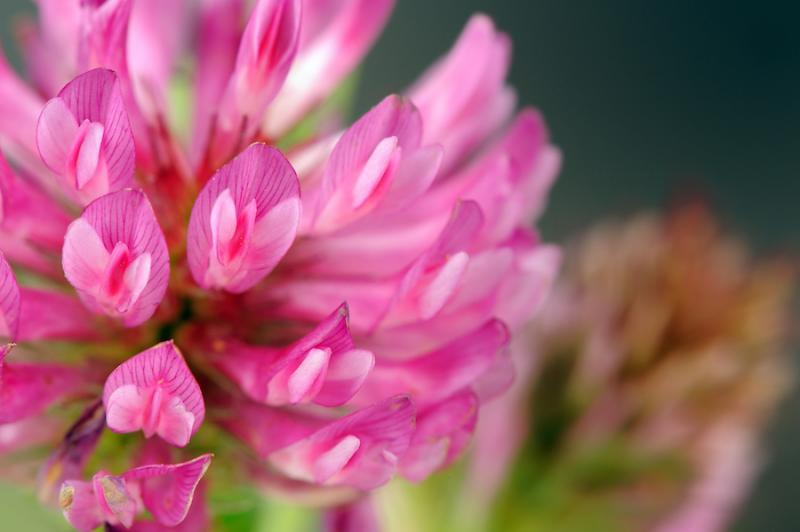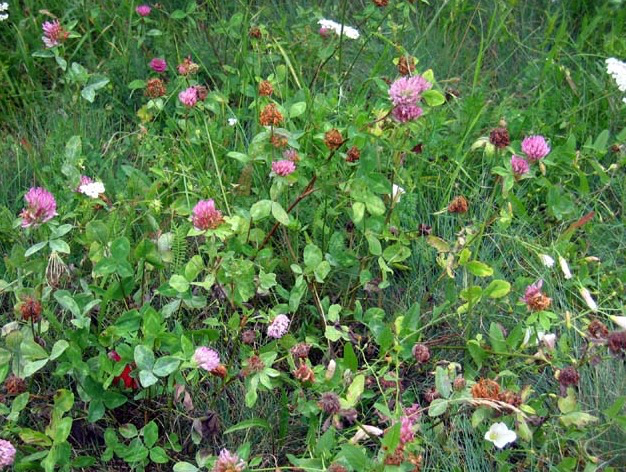 Mankind is in constant the constant search for exotic remedies, often neglecting some of the simple cures that grow practically in our own back yards. Red clover is one of those remedies. It's a gentle, but powerful alterative that can be used for skin problems like acne, respiratory and lymphatic congestion, and even cancer.
Mankind is in constant the constant search for exotic remedies, often neglecting some of the simple cures that grow practically in our own back yards. Red clover is one of those remedies. It's a gentle, but powerful alterative that can be used for skin problems like acne, respiratory and lymphatic congestion, and even cancer.
A member of the pea family and closely related to alfalfa, red clover can often be spotted in lawns, pastures, and on roadsides. I saw it growing everywhere on my recent trip to Washington state. Although it grows like a weed, it is also cultivated as a forage crop for cattle and poultry. It's also used as a cover crop to increase soil fertility. As a legume, it helps fix nitrogen from the atmosphere into the soil.
People can eat it, too, but eating too much clover of any kind can make humans bloat. We aren't able to digest it very well as we don't have the enzymes grazing animals do. However, like alfalfa, the seeds can be sprouted to make some tasty greens in the winter months.
As an herbal remedy, red clover is a blood purifier or alterative, meaning it helps to gently clean up the internal environment of the body to remove toxins and move stagnant fluids. It is often used to clear up skin conditions like acne, rashes and eczema. It is also used to treat overactive, dry, irritable or inflamed skin because of its soothing, cooling, and moistening properties. It is typically combined with other blood purifying herbs like burdock and yellow dock, in the blood purifying formulas. However, it also makes a pretty nice tea just by itself.
Red clover is less well known for its mild expectorant action, but it is useful for the lungs, too. In Russia, folk healers treat asthmatic patients with red clover and in Ireland it is used for winter colds. It has also been used for coughs, whooping cough, wheezing, and bronchitis. Red clover increases lymph flow, so it relieves lymphatic congestion and helps to reduce swollen lymph nodes.
 Some Native American tribes used red clover to treat gynecological problems. Modern research supplies evidence to support this use. Red clover contains isoflavones that have phytoestrogenic activity which may be helpful for menopause or menstrual irregularities. Phytoestrogens bind to receptor sites for estrogens, which blocks them from being stimulated by both the body’s natural estrogens and environmental chemicals with estrogenic activity, known as xenoestrogens. Red clover inhibits the stronger xenoestrogens and thus is useful for both preventing and treating estrogen-dependent cancers. Besides phytoestrogens, red clover contains rather high amounts of tocopherol, a form of vitamin E that has been shown to help prevent breast tumors in animals.
Some Native American tribes used red clover to treat gynecological problems. Modern research supplies evidence to support this use. Red clover contains isoflavones that have phytoestrogenic activity which may be helpful for menopause or menstrual irregularities. Phytoestrogens bind to receptor sites for estrogens, which blocks them from being stimulated by both the body’s natural estrogens and environmental chemicals with estrogenic activity, known as xenoestrogens. Red clover inhibits the stronger xenoestrogens and thus is useful for both preventing and treating estrogen-dependent cancers. Besides phytoestrogens, red clover contains rather high amounts of tocopherol, a form of vitamin E that has been shown to help prevent breast tumors in animals.
Red clover has been studied as a natural cancer treatment for over one hundred years and by over thirty cultures around the world. It is a key ingredient in traditional anti-cancer formulas like Jason Winters tea and the famous Hoxsey cancer formula. It has also been used to create drawing salves for skin cancer. One way of doing this was to boil a decoction of red clover down to a thick paste, then apply this carefully to draw out infection and get rid of tumors, cysts and warts.
The red clover flower essence helps maintain calm in the midst of a crisis and helps to avoid getting caught up in the group mindset. If all the bad news going on in the world is adversely affecting you, this flower essence might be just what you need.
It’s clear to see that this simple wayside herb is a powerful ally in the quest for better health. So, in your search for remedies, don't overlook what may be growing in your own backyard. In fact, if you keep your eyes open when you're walking or driving, you'll probably spot some of this common plant growing in meadows or fields as it's in bloom right now in many parts of North America. Just look for the clover-like leaves with three leaflets and the big red, clover flowers as pictured in the photo above.
Steven's Articles
-

-
The Health Benefits and Problems with Coffee
This popular caffeinated beverage can be beneficial…
October
-

-
Understanding Caffeine & Cellular Adaptation
Preserving the power of caffeine's buzz and the…
September
-

-
Horseradish
A pungent spice for aiding protein metabolism…
-

-
Banaba or Crepe Myrtle
A beautiful tree from Southeast Asia whose leaves…
August
-

-
Monkeyflowers
Flower essences to help see ourselves more clearly…
-

-
Mariposa Lilies
Strengthening the bond between mother and child…
-

-
The Noble Bay Leaf
A common kitchen herb for aiding digestion and…
-

-
Epimedium: Horny Goat Weed
A circulatory stimulant and kidney yang tonic…
July
-

-
The Medicinal and Nutritional Benefits of Apricots
A nutritious fruit and valuable medicinal seed for coughs
-

-
Dogwoods
Asian dogwood is used to stop excessive discharge,…
June
-

-
Neem: The Village Pharmacy
A popular Ayurvedic remedy for dental and immune…
-

-
Spilanthes: The Toothache Plant
A traditional remedy for teeth and gums, as well…
-

-
Forsythia
An anti-inflammatory, fever-reducing, and infection fighting herb
May
-

-
Buckwheat (Kashi)
A delicious, high protein, gluten-free, gut-healthy food
-

-
Leaky Gut Syndrome
Plugging the leaks on the underlying cause of…

